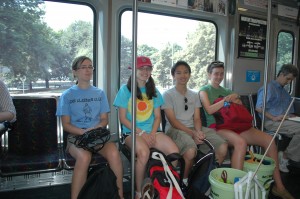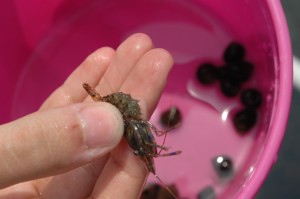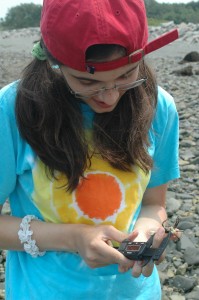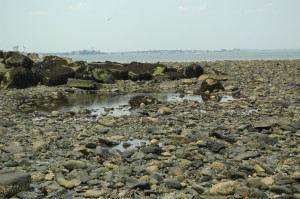After a busy week of field surveys, the MIT Ocean Science Interns headed out to Lovells Island for one more transect survey on this quiet harbor island. Getting to Lovells is no small task. First, we pack up all of our gear and hop on the subway to Downtown Boston, carting our equipment-filled buckets through the Financial District until we arrive at Long Wharf.
After catching a connecting ferry from George’s Island, we arrived at our field site about an hour before low tide and got straight to work. We found that, compared to Spectacle Island, there tends to be a lot more life in our quadrats, particularly as we move closer to the water’s edge.
Today, we found a creature not yet seen on any of our intertidal zone surveys. Lurking quietly next to a rock was a shrimp! After enlisting the team to corral and finally capture the specimen, we quickly discovered that this was an egg-bearing female. We carefully photographed and documented this individual so we could get a more specific species identification back in the lab and released this exciting find back into its home in the mid-littoral zone.
Today was also a remarkable day for crab abundance. In one 1/4 meter quadrat we found over 20 crabs. Each crab is identified to the species and sex, and the width of its carapace is measured using digital calipers.
Our brave interns aren’t afraid to get their hands dirty and chase after these elusive, and sometimes aggressive, arthropods. They range in size from minuscule individuals that require a magnifying glass to ID, to larger crabs that are nearly the size of our palms!
Overall, we have found that most of the crabs in our surveys are Asian shore crabs, an introduced species characterized by a square-shaped carapace. Today, we also found several green crabs. This species was introduced to the Atlantic Coast in the 1800s and is a voracious predator, capable of eating up to 40 clams a day. They can be identified by counting the 5 spines on either side of their carapace.
After gathering a weeks worth of data, the team will return to the lab at MIT Sea Grant to compile and analyze their data, identify unknown specimens, and put together a final report. The data that they collected will be used by the National Park Service and the MWRA as part of a long-term series of studies on the biodiversity of the Boston Harbor Islands.






